Another Summer Tour today, the second of a 3-day long weekend of tours. We spent the morning looking for Birds of Prey, the afternoon at Titchwell and the evening with Owls and Nightjars. It was a lovely, warm, sunny day, perfect summer birding weather.
To start the day, we drove inland, meandering our way from the coast. There were still lots of House Martins coming in and out of the eaves of the houses and barns around the villages. At one point, we came across a large gathering of House Martins on the wires, which all took off just as we drove up. A reminder that the breeding season is slowly coming to an end, and autumn is just around the corner!
We parked by a farm track and walked up a lane with thick hedges either side. We could hear Yellowhammers singing, and one perched briefly on the wires ahead of us, but unfortunately not long enough for all the group to get onto it. Several Common Whitethroats darted in and out of the vegetation ahead of us, flying out from the hedge and further along the track before diving back in. A couple of Blackbirds did the same thing too.
There were lots of butterflies out in the overgrown verges here – Ringlets, Meadow Browns, Gatekeepers, Red Admirals, bright orange Commas and several Skippers, of which the only one that stopped long enough for us to confirm the ID was an Essex Skipper. A rather smart Longhorn Beetle (going by the catchy name of Agapanthia villosoviridescens!) unfortunately wasn’t hanging around either.
 Essex Skipper – a wide variety of butterflies were along the track
Essex Skipper – a wide variety of butterflies were along the track
Up on slightly higher ground, we found a convenient place to stand with a good view of the surrounding countryside. We managed to see a variety of raptors from here. As the air warmed, the Common Buzzards started to circle up, calling. Eventually we could see them in all directions. As one circled high above the fields, we could see a smaller bird of prey above it, which then started diving at it – a Sparrowhawk. A distant Marsh Harrier spiralled up too, as did a Kestrel or two.
There were other birds here too. We could see a big flock of Swifts & House Martins over some trees, hawking for insects. A smaller group of Swallows appeared over a distant field. A couple of Stock Doves flew back and forth and Skylarks sang overhead or fluttered over the fields. We regularly heard the twitter of Linnets overhead too. Another Yellowhammer was singing from the hedge just along from us, but it was on the wrong side and we couldn’t see it from here. A Chiffchaff called and worked its way along the hedge into the trees.
After a while, we decided to walk back. We could hear a soft tacking call from the tall hedge ahead of us, not as harsh as a Blackcap, more like the ‘tsk, tsk’ of someone tutting. It sounded like a Lesser Whitethroat, and as we got closer our suspicions were confirmed when it hopped up into top of hedge. It seemed to be annoyed at something, but we couldn’t see what, and it quickly appeared to transfer its ire to us instead as we passed.
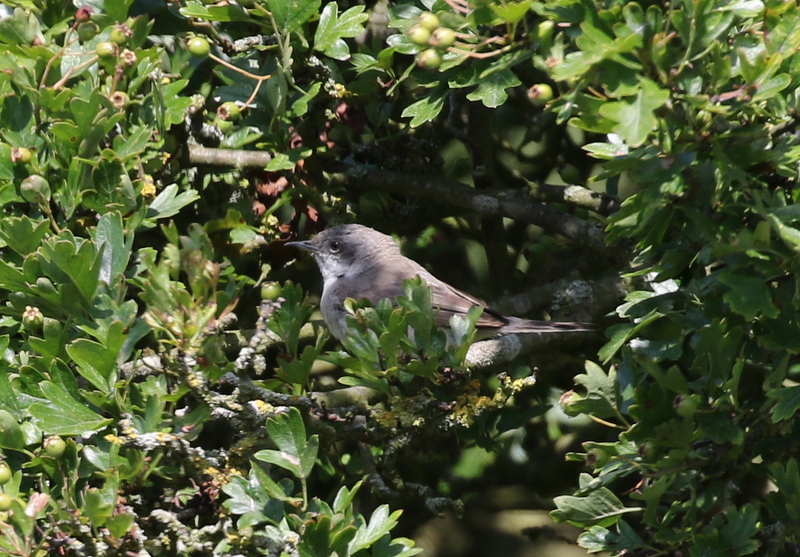 Lesser Whitethroat – tacking from the hedge as we walked along
Lesser Whitethroat – tacking from the hedge as we walked along
As we walked back towards the car, we could hear another Yellowhammer singing. This one we finally managed to get in the scope so everyone could see it. A nice bright yellow male, we could see its throat moving as it sang. A Bullfinch called from somewhere behind us, but it was not so obliging and remained hidden deep in bushes.
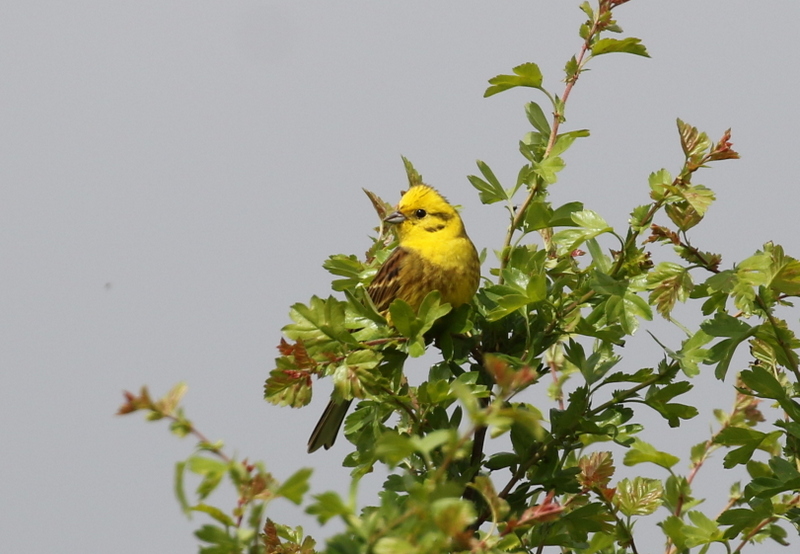 Yellowhammer – a smart male taken here earlier in the year
Yellowhammer – a smart male taken here earlier in the year
From here, we meandered our way west. The fields and verges are nicely overgrown now, but it does mean it is harder to see much on our way past. A nice addition to the day’s list was provided by an adult Mediterranean Gull which circled over the road with several Black-headed Gulls, flashing its bright white wing tips, before dropping down into a field out of sight behind the hedge.
Dropping back down to the coast, we made our way to Titchwell. It was not too busy, so we had a quick look around the overflow car park. There was no sign of the Turtle Dove which has been here recently (though we found out why later!). There were lots of Greenfinches in the bushes, and a couple of Chaffinches too. A flock of tits came through – Blue, Great and Long-tailed Tits – and accompanying them were a couple of Blackcaps and a Willow Warbler.
There were more tits and finches on the feeders in front of the visitor centre. Given the time, we decided to walk out to have a look at Patsy’s Reedbed first. We made a brief stop in in at Fen Hide on the way past, but the pool is now overgrown with reeds and all was quiet, so we didn’t stay long.
When we got to Patsy’s Reedbed, just about the first bird we set eyes on was a female Red-crested Pochard, out in front of the screen. The pale-tipped dark bill immediately set it apart from an eclipse male, which still retains its bright red bill even in eclipse plumage. Three full grown juvenile Common Pochard were asleep in front of the screen too. A Great Crested Grebe nearby was bathing at first, then started swimming around with its head underwater, looking for food. Further over, a Little Grebe was diving constantly. Several Avocets out here still had young in various stakes of development.
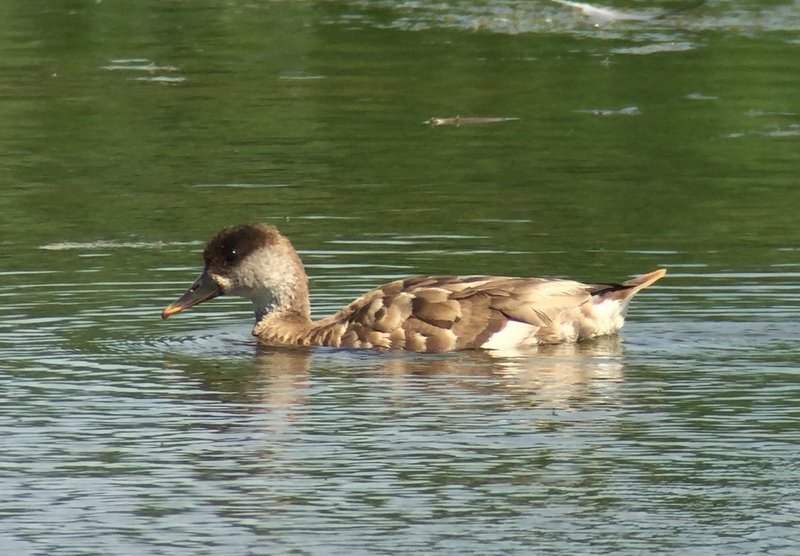 Red-crested Pochard – a female
Red-crested Pochard – a female
With the morning gone already, we made our way back to the picnic area for lunch. We found a bit of shade. As we got up to leave, a Robin was sunning itself in a bright spot by the bench.
 Robin – sunning itself
Robin – sunning itself
After lunch, we made our way out onto the main part of the reserve. The grazing marsh ‘pool’ is still mostly dry, but for a few puddles, which held very few birds today. The reedbed pool was more productive. Another Great Crested Grebe had two well-grown young in tow and another Little Grebe had a very small juvenile with it. A female Tufted Duck was also accompanied by two small ducklings, and there were a few Common Pochard, a single Shoveler and a couple of Teal, to go with the regular Mallard, providing a nice selection of wildfowl.
We could hear the ‘pinging’ call of Bearded Tits from the reeds further along but there was no sign of any from the main path when we got there. There was a nice cooling breeze now, but this meant they were probably keeping their heads down. A distant Marsh Harrier circled up briefly, but otherwise they were rather quiet this afternoon.
Before we even got to Island Hide, we could see several Spoonbills out on the freshmarsh. There were at least eight of them, tucked in on the edge of one of the islands, doing what Spoonbills do best, sleeping! Occasionally one or other would lift its head briefly, flashing its bill, before tucking it back in and going back to sleep.
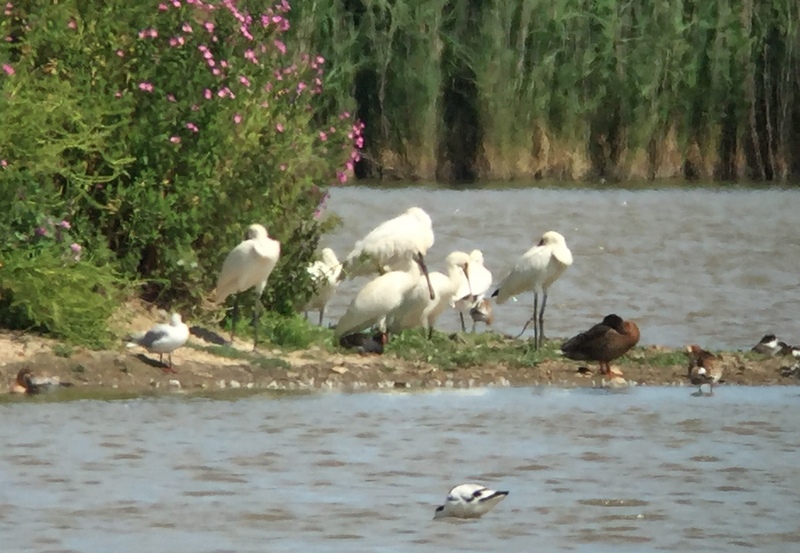 Spoonbills – we could see at least 8 asleep on the freshmarsh
Spoonbills – we could see at least 8 asleep on the freshmarsh
From the hide, we could see a nice selection of different waders out on freshmarsh. A careful scan with the scope picked up the Little Stint, out on one of the islands. It was mostly on own, but worked its way along towards the Dunlin, at which point it was possible to see just how ‘Little’ it was. We counted 37 Dunlin today, numbers along the coast are steadily increasing now, along with a single Knot. There were also lots of Avocets and Black-tailed Godwits, and a selection of Ruff in a confusing array of colours as they moult out of their gaudy breeding plumage.
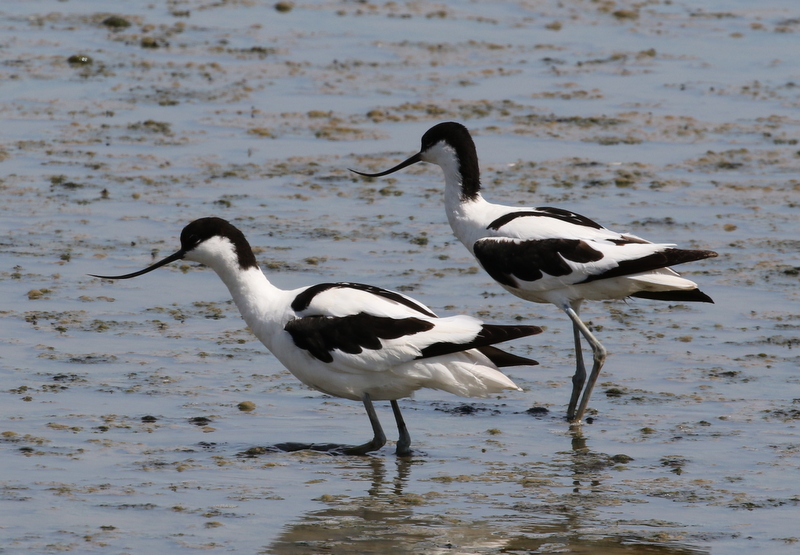
Lots of gulls and terns were loafing around on the islands. We could see lots of Common Terns, and several Sandwich Terns as well today. A careful scan through them and we came across one with an all-red bill, shorter than a Common, and also very short legs – a single Arctic Tern. In amongst all the Black-headed Gulls we found a single Common Gull, and several Lesser Black-backed Gulls. A couple of juvenile Shelduck were dabbling in the mud in front of the hide.
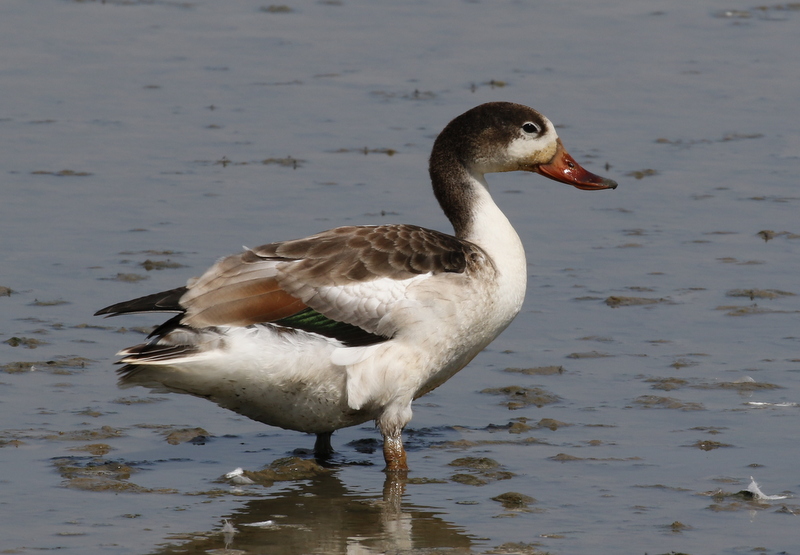
The biggest surprise from Island Hide was finding the Turtle Dove feeding quietly on the grassy margin of the main island. It was very distant from here and inside the new wire fence, but even at that range we could see its bright rusty orange back and wings and pinkish breast. A couple of Bearded Tits made a most welcome appearance form the hide, feeding on the mud, in and out of the edge of the reeds, two bright tawny-coloured juveniles.
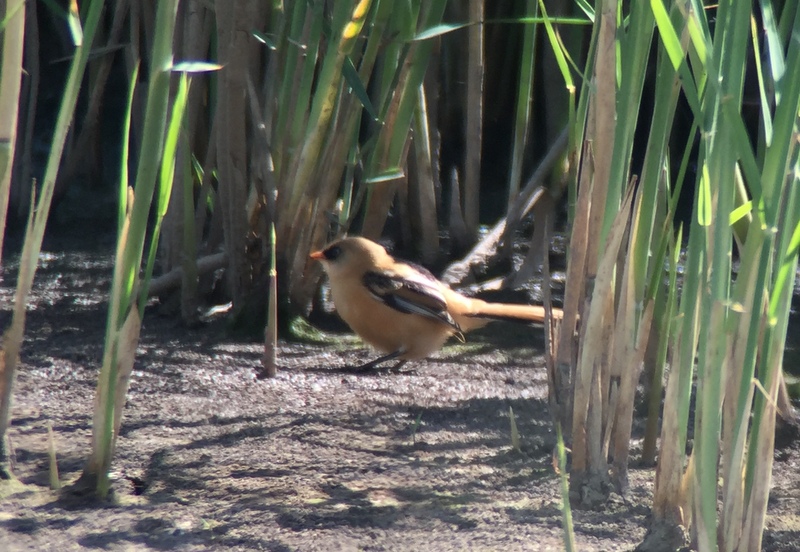
Round at the Parrinder Hide, we finally located the Spotted Redshanks just where we thought they might be, in the far corner. There were at least seven, though probably quite a few more as they kept disappearing behind the islands. One was still liberally speckled with black summer plumage, but the rest were mostly in their silvery grey winter garb.
A juvenile Little Ringed Plover was in and out of view on a patch of drier mud, and we heard two Common Sandpipers calling as they helpfully dropped in along the water’s edge nearby. A Whimbrel did much the same – we heard it calling as it approached and, after circling over the hide, it dropped down out in the middle for a quick bathe before flying off again. A second Whimbrel didn’t even land. The vast majority of the Black-tailed Godwits which we get here are Icelandic (subspecies islandica), but it is possible to find the occasional Continental Black-tailed Godwit (limosa) too sometimes. It can be a bit of a dark art at this time of year, with subtle features relating to size and structure being the main things to look for, but a challenge was issued and we did find a single limosa out at the back of the freshmarsh.
The Yellow Wagtails proved slightly elusive at first, with just a quick glimpse of one on the fence. But eventually they gave themselves up nicely, at least three of them. A juvenile landed on the mud in front of the hide, a female perched up on the fence again and a nice bright male was unfortunately right at the opposite side against the reeds, but still stood out like a sore thumb! The Turtle Dove also put in a brief appearance a bit closer from here, but disappeared immediately out of view. When the Spoonbills finally woke up they flew off over the bank towards Brancaster.
Unfortunately, at this stage, we were running out of time – there had been so much to see around the freshmarsh today. We had a quick look at the Volunteer Marsh, but it was very quiet out there, then it was back to the car and heading for home.
Nightjar Evening
We met up again later on, after a break and something to eat, for the Nightjar Evening. Our first target was to look for some owls, and Little Owl was a particular request, so we drove out to a favoured spot. It didn’t take long to find a distant Little Owl perched up on some old farm buildings. We got it in the scope but after a couple of minutes it flew down to the ground and was lost to view. Only at this point did we realise that a second Little Owl was perched on another barn much closer to us. We got great views of it in the scope, sitting quietly in the last of the evening sunshine soaking up some rays. A Brown Hare appeared and also provided a nice distraction.
 Little Owl – enjoying the evening sunshine
Little Owl – enjoying the evening sunshine
From here it was on to look for Barn Owls. Normally they are very busy at this time of year, with young about to fledge, but this year our regular area appears rather quieter. There are several pairs around here, but the birds at the moment are not appearing until much later in the evening. It seems most likely that the cold, wet spring has affected breeding success. One Barn Owl eventually came out, a female, and started hunting. We watched it working its way back and forth around a field. When it did finally catch something, it showed no sign of taking its prey back to the nest, but disappeared out of view with it, presumably to a convenient perch. With Nightjars our main target for the evening, we couldn’t linger longer here for more Barn Owls to emerge.
So, it was up to the Heath next. Almost immediately after we had walked out to our regular spot, we heard a Nightjar call. A good job we hadn’t waited longer for the Barn Owls! Shortly afterwards, the first Nightjar started churring. First one churred in front of us, then another started up behind us. Even better, the latter then flew around and landed in a tree nearby. It was on a dead branch, out in full view, where we could get fantastic view of it in the scope. It perched there for several minutes, looking round, churring. Stunning!
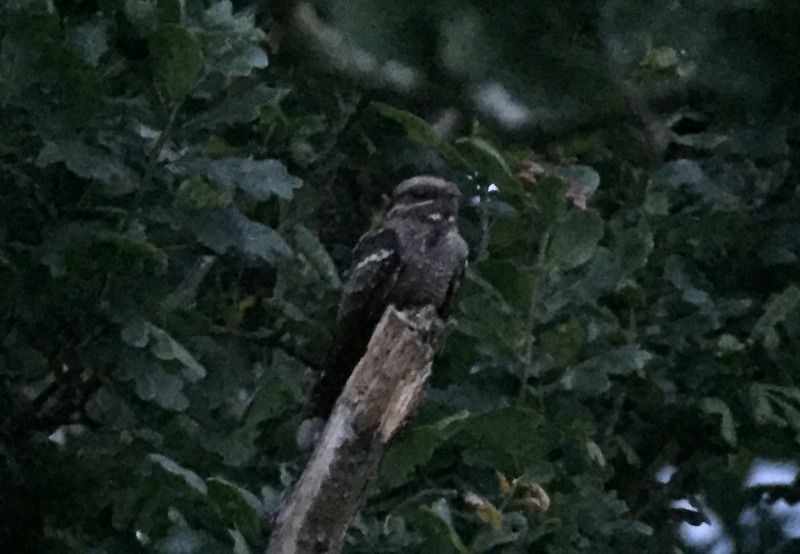 Nightjar – perched out churring in full view for us
Nightjar – perched out churring in full view for us
We stayed for a while listening to the Nightjars. There were at least 3 churring males within earshot tonight, and calls off suggested one or two females too. The males were constantly switching churring posts, flying round their territories and advertising their presence. Finally, as the light faded, we called it a day, and a long and fruitful one it had been too!
















